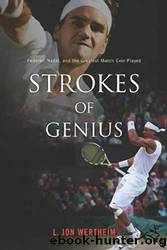Strokes of Genius by L. Jon Wertheim

Author:L. Jon Wertheim [Wertheim, L. Jon]
Language: eng
Format: epub
Published: 0101-01-01T00:00:00+00:00
Still grooving his forehand, Federer made Nadal labor to hold serve. 1â1. And then the match nearly ended.
Early in his fourth-round encounter with Mikhail Youzhny, Nadal slipped while chasing a ball. As his body jerked in one direction, his right knee had other ideas. Nadal lay supine on the grass, and the odds of Federer's winning the title suddenly spiked. A television replay of Nadal's slip was uncomfortable to watch. Scared after having heard what he describes as "a little crack from behind," Nadal had summoned Michael Novotny, a multilingual trainer employed during the year by the ATP who, for the sake of continuity and consistency, had been subcontracted by Wimbledon for the two weeks. At the ensuing changeover, Novotny stretched out Nadal's leg, applied an ointment, and bandaged the knee. Between the original assessment and the injury time-out, the treatment lasted nearly nine minutes. Aided by adrenaline, Nadal surrendered just a few more games, polishing off Youzhny in straight sets. But the sensation in his knee was sufficiently intense that Nadal would require painkillers after the match.
For his next two matches, Nadal showed no trace of injury, his mobility not reduced in the slightest. But as a precaution, for the final Novotny stationed himself courtside, behind netting near the players' entrance. For two sets, he stood idly enjoying the match, a spectator with a prime spot. But early in the third set, Novotny's viewing pleasure was interrupted. Serving at 1â1, Federer maneuvered Nadal around the court with a series of penetrating shots. Pouncing on a short ball, Federer pegged a forehand to the left side of the court. Nadal had anticipated a shot to the right. It was a classic case of wrong-footing. As Nadal attempted to self-correct and retrieve the shot, his right knee remained in place like a stubborn child. He fell to the ground, winced, and, in pin-drop quiet, attempted to rise. He fell flat on his back. His ass, already grass-stained, appeared to be plastered to the court. In Nadal's section of the players' box, the faces looked cadaverous. His shirt billowing in the wind, Federer walked to the net, cast a look of concern, and asked Nadal if he was okay. Nadal nodded unconvincingly.
If one critique can be leveled at Nadal's game, it would be that his unceasingly physical, almost violent style of playâall that twisting and pounding and grindingâputs so much stress on his body that he's a medical disaster waiting to happen. One tennis trainer notes that Nadal's Nike court shoes are often uncommonly scuffed and worn by the end of a match. "Why would you think his body would be any different?" Eben Harrell, a fine writer for Time magazine, recently asked Rafael Maymo, Nadal's baby-faced physiotherapist, which of Nadal's body parts are under the most strain when he plays. "Shoulder, feet, legs, and back," Maymo responded. Then: "Oh, wait, that's every part." In his brief career, Nadal has already suffered a number of maladies, including an elbow injury, a stress
Download
This site does not store any files on its server. We only index and link to content provided by other sites. Please contact the content providers to delete copyright contents if any and email us, we'll remove relevant links or contents immediately.
The Light of Days by Judy Batalion(829)
The Crime Book by DK(704)
Chasing the Thrill by Daniel Barbarisi(657)
1312, Among the Ultras by James Montague(586)
The Doctor Who Fooled the World by Brian Deer(565)
Till Murder Do Us Part by James Patterson(559)
Invention by James Dyson(559)
E.R. Nurses by James Patterson(559)
The Complete Correspondence 1928-1940 by Theodor W. Adorno & Walter Benjamin(505)
Climb by Susan Spann(490)
Mind Games by Neville Southall(479)
Space 2069 by David Whitehouse(475)
The Dream Architects by David Polfeldt(475)
The Reporter by Mark Paul Smith(475)
Surely you Ìre joking, Mr Feynman by Richard Feynman(458)
If You Should Fail by Joe Moran(442)
Masterful Marks: Cartoonists Who Changed the World by Monte Beauchamp(431)
The 'Wolfman' by Sigmund Freud & Sigmund Freud(428)
Banking and Beyond by Unknown(422)
